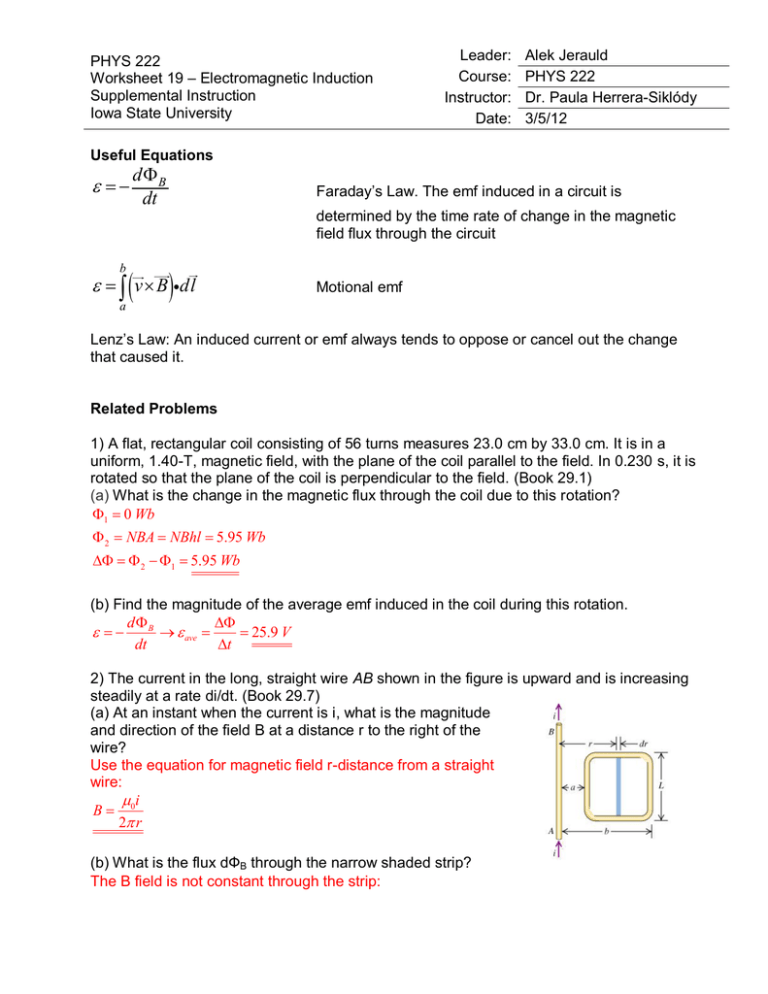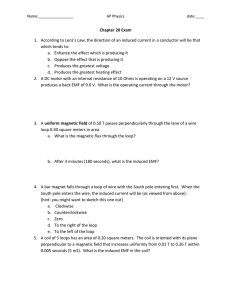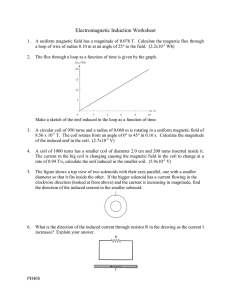PHYS 222 Worksheet 19 Electromagnetic
advertisement

PHYS 222 Worksheet 19 – Electromagnetic Induction Supplemental Instruction Iowa State University Leader: Course: Instructor: Date: Alek Jerauld PHYS 222 Dr. Paula Herrera-Siklódy 3/5/12 Useful Equations dB dt Faraday’s Law. The emf induced in a circuit is determined by the time rate of change in the magnetic field flux through the circuit b v B dl a Motional emf Lenz’s Law: An induced current or emf always tends to oppose or cancel out the change that caused it. Related Problems 1) A flat, rectangular coil consisting of 56 turns measures 23.0 cm by 33.0 cm. It is in a uniform, 1.40-T, magnetic field, with the plane of the coil parallel to the field. In 0.230 s, it is rotated so that the plane of the coil is perpendicular to the field. (Book 29.1) (a) What is the change in the magnetic flux through the coil due to this rotation? 1 0 Wb 2 NBA NBhl 5.95 Wb 2 1 5.95 Wb (b) Find the magnitude of the average emf induced in the coil during this rotation. d B ave 25.9 V dt t 2) The current in the long, straight wire AB shown in the figure is upward and is increasing steadily at a rate di/dt. (Book 29.7) (a) At an instant when the current is i, what is the magnitude and direction of the field B at a distance r to the right of the wire? Use the equation for magnetic field r-distance from a straight wire: i B 0 2 r (b) What is the flux dФB through the narrow shaded strip? The B field is not constant through the strip: d B(dA) 0 i (drL) 2 r (c) What is the total flux through the loop? b i iL b 0 Ldr 0 ln 2 r 2 a a (d) What is the induced emf in the loop? dB di L b di d B 0 ln dt dt 2 a dt (e) Evaluate the numerical value of the induced emf if a = 12 cm, b = 36 cm, L = 24 cm, and di/dt = 9.60 A/s. 5.06(107 ) V 3) The armature of a small generator consists of a flat, square coil with 160 turns and sides with a length of 1.55 cm. The coil rotates in a magnetic field of 8.05×10 −2 T. What is the angular speed of the coil if the maximum emf produced is 2.60×10 −2 V? (Book 29.13) NBL2 sin(t ) max d NBL2 cos(t ), cos(t ) 1 for max dt max 8.40 rad / s NBL2 4) A circular loop of wire is in a region of spatially uniform magnetic field, as shown in the figure. The magnetic field is directed into the plane of the figure. (a) Determine the direction of the induced current in the loop when B is increasing. The induced current always wants to oppose the change in flux, so when B is increasing, the circular loop will want to induce a current so that the current creates a B field against the increasing B-field. Thus, the induced current will be Clockwise. (b) Determine the direction of the induced current in the loop when B is constant with value B0. Since there is no change in flux because B is constant and A is constant, so there is NO induced current. 5) Using Lenz's law, determine the direction of the current in resistor ab of the figure when: (Book 29.17) (a) Switch S is opened after having been closed for several minutes. When the switch is closed, there is a current in coil A. When the switch opens, the current decreases (to zero), thus the induced current in coil B wants to produce a B- field in the same direction as originally. In order to produce this new B-field, the current must flow through the resistor in the direction from a to b. (b) Coil B is brought closer to coil A with the switch closed. When Coil B is brought closer to coil A, the flux through coil B increases. To oppose this increase in flux, the current must flow through the resistor in the direction from b to a. (c) The resistance of R is decreased while the switch remains closed. A decrease in resistor R would increase the current through coil A leading to an increase in flux through coil B. To oppose this increase in flux, the current must flow through the resistor in the direction from b to a.





